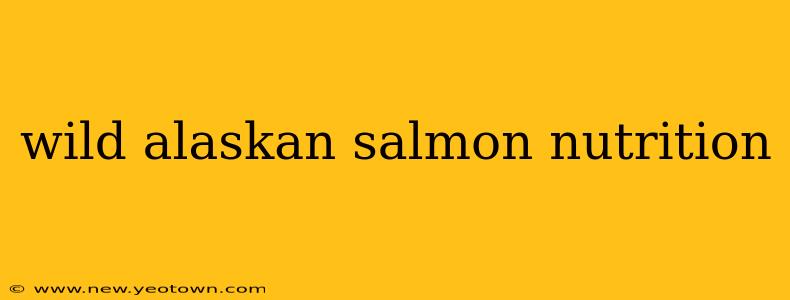The crisp, clean air of Alaska, the rugged coastline, and the icy waters – these are the elements that nurture the extraordinary wild Alaskan salmon. More than just a delicious meal, this fish is a nutritional powerhouse, packed with benefits that extend far beyond its rich, savory flavor. Let's dive deep into the incredible nutritional profile of this prized catch.
What makes Wild Alaskan Salmon so nutritious?
Wild Alaskan salmon isn't just any salmon; it thrives in its natural environment, feeding on a diverse diet of krill, shrimp, and other small fish. This natural diet is key to its superior nutritional composition compared to farmed salmon. It's a difference you can taste and, more importantly, feel in the positive impact on your health. Wild Alaskan salmon boasts significantly higher levels of essential Omega-3 fatty acids, vitamins, and minerals.
What are the key nutrients in Wild Alaskan Salmon?
Wild Alaskan salmon is a nutritional goldmine. Let's break down some of its most important components:
-
Omega-3 Fatty Acids: These are arguably the star of the show. Wild Alaskan salmon is exceptionally rich in EPA (eicosapentaenoic acid) and DHA (docosahexaenoic acid), crucial for heart health, brain function, and reducing inflammation. These Omega-3s are vital for overall well-being, contributing to a lower risk of chronic diseases.
-
Protein: A complete protein source, meaning it provides all nine essential amino acids your body needs but can't produce on its own. This is critical for building and repairing tissues, supporting muscle growth, and boosting metabolism.
-
Vitamin D: Essential for calcium absorption, bone health, immune function, and mood regulation. Wild Alaskan salmon is a fantastic source, particularly important for those with limited sun exposure.
-
Vitamin B12: Crucial for nerve function, red blood cell formation, and DNA synthesis. Often lacking in vegetarian and vegan diets, wild Alaskan salmon provides a readily available source.
-
Astaxanthin: A powerful antioxidant that gives wild salmon its vibrant pink color. This carotenoid possesses remarkable anti-inflammatory and cell-protective properties.
-
Selenium: A trace mineral vital for thyroid function, antioxidant defense, and immune health.
-
Potassium: Essential for maintaining healthy blood pressure and fluid balance.
Is Wild Alaskan Salmon better than farmed salmon?
This is a frequently asked question, and the answer is generally yes, when comparing nutrition. While farmed salmon provides some nutritional value, wild Alaskan salmon typically contains significantly higher levels of Omega-3 fatty acids, astaxanthin, and vitamins. This difference stems from the salmon's diet and living conditions. Wild salmon have a more diverse and natural diet, leading to a richer nutrient profile. Furthermore, concerns about potential contaminants and the use of antibiotics and chemicals in farmed salmon production also need to be considered.
How much Wild Alaskan Salmon should I eat per week?
The recommended intake varies based on individual needs and dietary preferences. However, aiming for at least two servings of wild Alaskan salmon per week is a great goal to incorporate these vital nutrients into your diet.
What are the health benefits of eating Wild Alaskan Salmon?
The impressive nutrient profile of wild Alaskan salmon translates to a wide array of health benefits, including:
-
Improved Heart Health: The high levels of Omega-3 fatty acids help lower triglycerides, blood pressure, and reduce the risk of heart disease.
-
Enhanced Brain Function: Omega-3s are crucial for brain health, supporting cognitive function, memory, and mood.
-
Reduced Inflammation: Astaxanthin and Omega-3s possess potent anti-inflammatory properties, beneficial for managing chronic inflammatory conditions.
-
Stronger Immune System: The abundance of vitamins and minerals contributes to a robust immune system, helping your body fight off infections.
-
Improved Eye Health: Omega-3s and astaxanthin protect against age-related macular degeneration.
Can I eat Wild Alaskan Salmon every day?
While there's no harm in enjoying wild Alaskan salmon daily, variety is key to a balanced diet. Including other sources of protein and nutrients will ensure you obtain a diverse range of essential vitamins and minerals.
How can I prepare Wild Alaskan Salmon?
Wild Alaskan salmon is incredibly versatile. It can be grilled, baked, pan-fried, or even enjoyed raw in sushi. Keep cooking times short to maintain its tenderness and nutritional value.
Wild Alaskan salmon is a true gift from nature, offering a delectable and incredibly healthy addition to your diet. By understanding its nutritional benefits and incorporating it into your meal plan, you can unlock the numerous advantages this extraordinary fish provides for your overall well-being.

